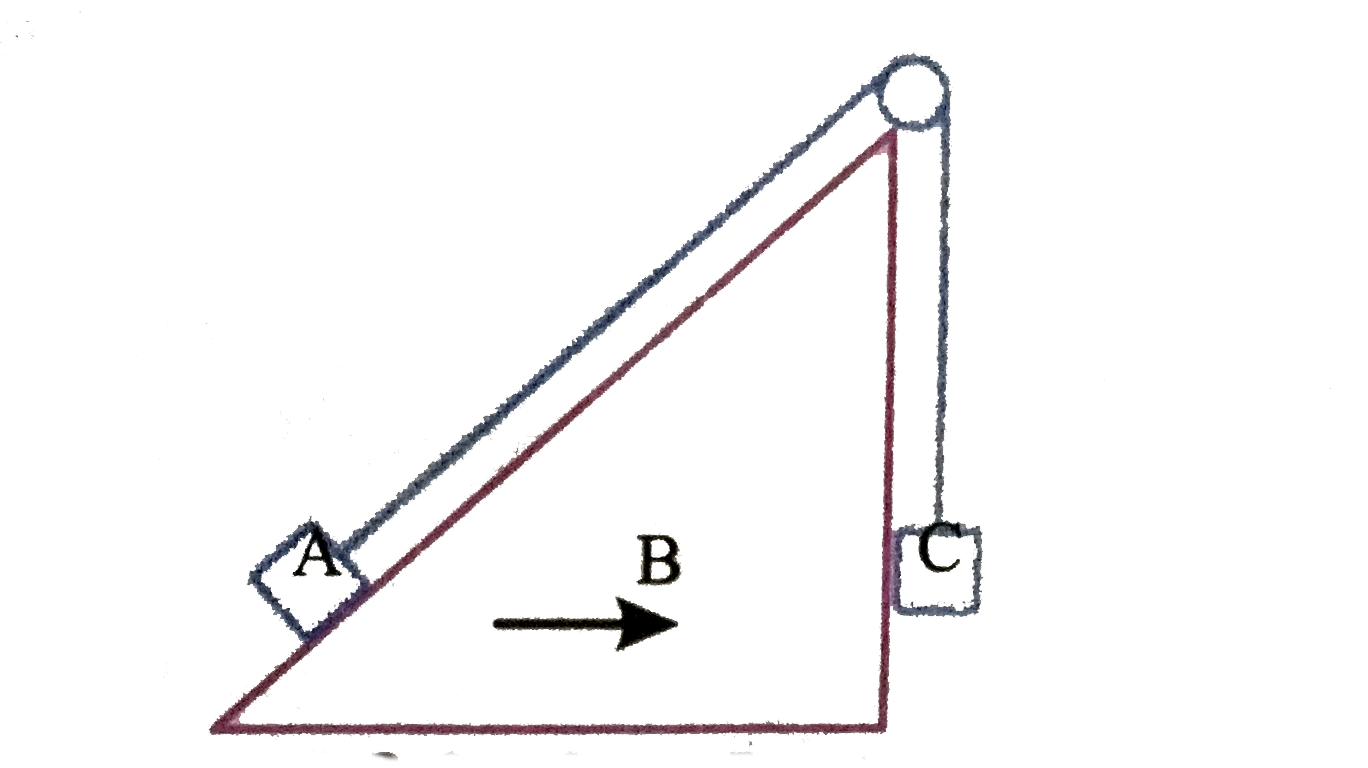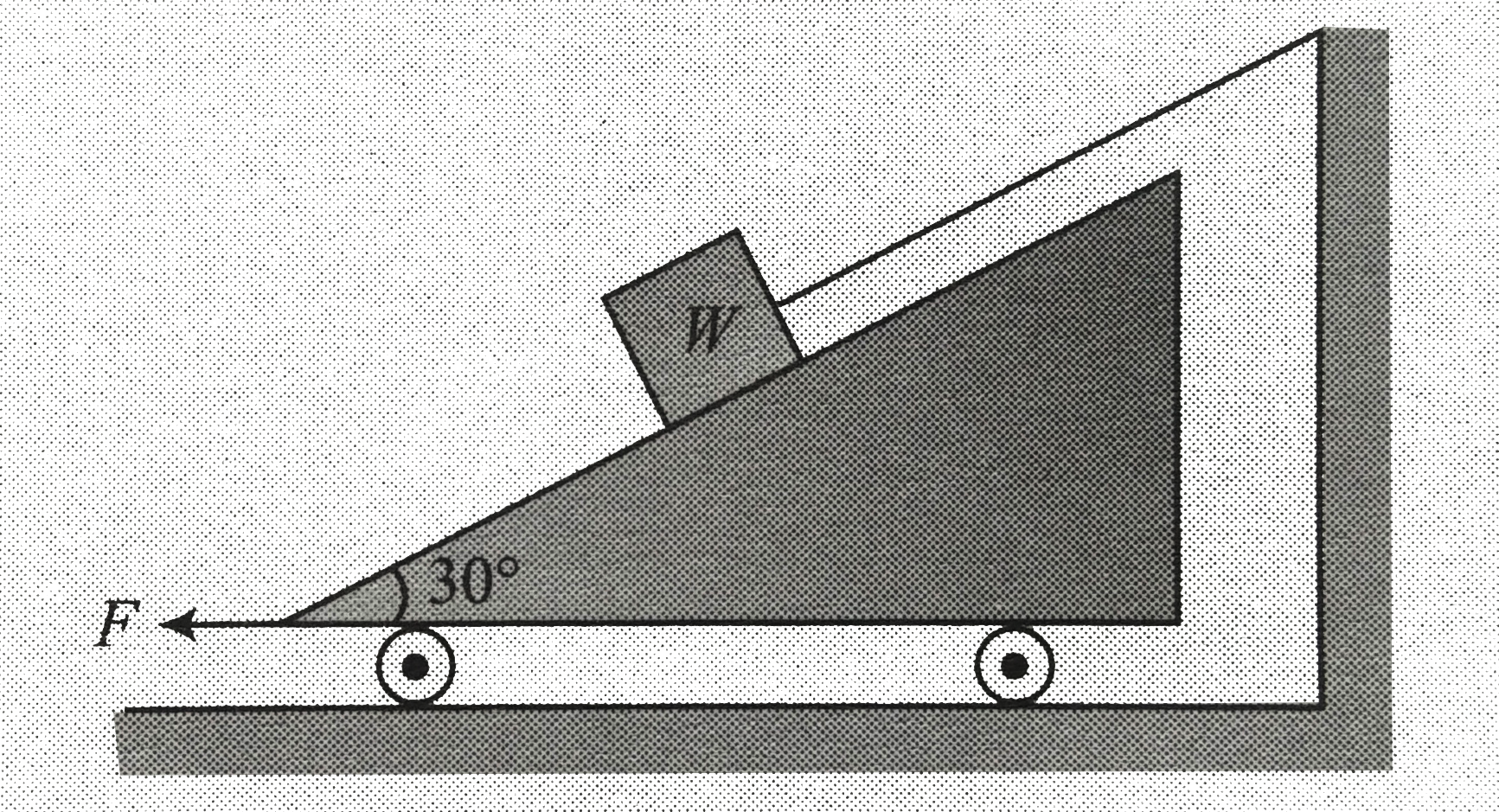Two blocks A and B of weight 4KN and 2KN respectively are in equilibrium position as shown in fig Coefficient of friction for both surfaces are same as 0.25 make calculations for the force P required to move the block A.
Considering equilibrium of block B. Resolving the force along the horizontal and vertical directions:Tcos 30° –µRb = 0;T cos 30° = µRb ...i Rb + Tsin 30° – Wb = 0;Tsin 30° = Wb – Rb ...iiDividing Equation i and ii We gettan 30° = Wb – Rb/µRb0.5773 = 2– Rb/0.25Rb;0.1443Rb = 2– RbRb = 1.748NFb = µRb = 0.25 × 1.748 = 0.437NConsidering the equilibrium of block A: Resolving the forces along the horizontal and vertical directions Fb + µRa – P = 0; P = Fb + µRaRa – Rb – Wa = 0; Ra = Rb +Wa = 1.748 + 4 = 5.748P = 0.437 + 0.25 × 5.748P = 1.874N.
Related Solutions
Three blocks are connected as shown in the figure. Calculate the minimum force required to make the block move with a constant velocity. The coefficient of friction on all surfaces is 0.25. [Assuming that the rod does not exert a force in the vertical direction]
View SolutionIn the fig. as shown mass of each block is same. The surface are rough with coefficient of friction . The block moves with acceleration . The frictional force on the block is . Calculate the value of
 View Solution
View SolutionThree blocks are connected as shown in the figure. Valculate the minimum force required to move the body with constant velocity. The coefficient of friction at all surfaces is 0.25.
View SolutionThree blocks are connected as shown in the figure. Valculate the minimum force required to move the body with constant velocity. The coefficient of friction at all surfaces is 0.25.
View SolutionBlock A weights 4 N and block B weights 8 N. The coefficient of kinetic friction is 0.25 for all surfaces. The force F to slide B at a constant speed, when A rests on B and moves with it, is
View SolutionFor the arrangement shown in the figure the coefficient of friction between the two blocks is mu . If both the blocks are identical and moving ,then the acceleration of each block is
View SolutionFor the arrangement shown in the figure the coefficient of friction between the two blocks is mu . If both the blocks are identical and moving ,then the acceleration of each block is
View SolutionBlock A weight 20 kg placed on a smooth surface. Weight B of 2 kg is mounted on the block . The coefficient of friction between the block and the weight is 0.25 Calculate the acceleration of the block and the weightand also the frictional force between the block and the weight when a horizontal force 2 N applied to the weight as shown in fig What will these quantities be if the horizontal force is 20 N? (g = 10ms^(-2))
View SolutionBlock A weight 20 kg placed on a smooth surface. Weight B of 2 kg is mounted on the block . The coefficient of friction between the block and the weight is 0.25 Calculate the acceleration of the block and the weightand also the frictional force between the block and the weight when a horizontal force 2 N applied to the weight as shown in fig What will these quantities be if the horizontal force is 20 N? (g = 10ms^(-2))
View Solution2 किग्रा का एक गुटका क्षैतिज से कोण पर बने आनत तल पर फिसलता है । गुटके व तल के बीच घर्षण गुणांक है। ज्ञात कीजिये -
(a) गुटके पर घर्षण बल तथा त्वरण ।
(b) गुटके को समान वेग से नीचे सरकाने के लिये आवश्यक बल ।
(c) गुटके को समान वेग से ऊपर सरकाने के लिये आवश्यक बल ।View SolutionCalculate the force P required to cause the block of weight W_(2)=200N just to slide under the block of weight W_(1)=100N shown in figure-2.83. What is the tension in the string AB ? Coefficient of friction mu = 0.25 for all surfaces in contact. [90 N, 20sqrt(2)N]
View Solutionब्लॉक तथा क्षैतिज सतह के मध्य घर्षण गुणांक है (चित्र - a में ) क्षैतिज बल F के अन्तर्गत ब्लॉक दांयी ओर गति करता है कुछ समय बाद (चित्र - b में) ऊर्ध्वाधर से कोण (इस प्रकार कि ) पर दूसरा बल P , ब्लॉक पर लगाया जाता है बल P के आरोपित होने के बाद, ब्लॉक का त्वरण -
 View Solution
View SolutionFig. 7. 187 (a) shows a system of two blocks of masses m and placed on a surface , there is no friction between the blocks and the surface . A force F is applied to the system as shown resulting in the motion of the system .

Fig. 7.187 (b) also shows a system of blocks of masses m and M . Masses m and M have , respectively , the same values as in Fig . 7.187 (a) . There is no friction between the lower block and the surface on which the system is placed but friction is present at the constant of the two blocks . A force F, having the same value as in Fig. 7.187 (a) , is applied to the lower block resulting in the motion of the system such that both blocks move together with a common acceleration . Match Column-I and II.
 View Solution
View SolutionA block of weight W is placed on a wedge and arranged as shown in fig. find the force F needed to hold the cart equilibrium if there is no friction.
View SolutionA block of weight W is placed on a wedge and arranged as shown in fig. find the force F needed to hold the cart equilibrium if there is no friction.
 View Solution
View SolutionA force of 100N is applied on a block of mass 3 kg as shown in the figure-2.164. The coefficient of friction between the surface and the block is 0.25.The frictional force acting on the block is: (Take g=10m/s^(2) )
View Solutionm द्रव्यमान का एक ब्लॉक ऐसे क्षैतिज फर्श पर रखा है जिसके साथ ब्लॉक का स्थैतिज घर्षण गुणांक है। ब्लॉक को गतिमान बनाने हेतु आवश्यक न्यूनतम बल का परिमाण तथा उसकी दिशा ज्ञात कीजिए।
View SolutionA cubical box of side L rests on a rough horizontal surface with coefficient of friction p. A horizontal force F is a applied on the block as shown in Fig. 15.4.6. If the coefficient of friction is sufficiently high so that the block does not slide before toppling, the minimum force required to topple the block is
View SolutionIn the figure, blocks A and B weigh 20 N and 100 N respectively. The blocks are being pressed by an unknown force F. If the coefficient of friction between the blocks is 0.1, find the force of friction between the block and the wall if the blocks are in equilibrium
 View Solution
View Solution
